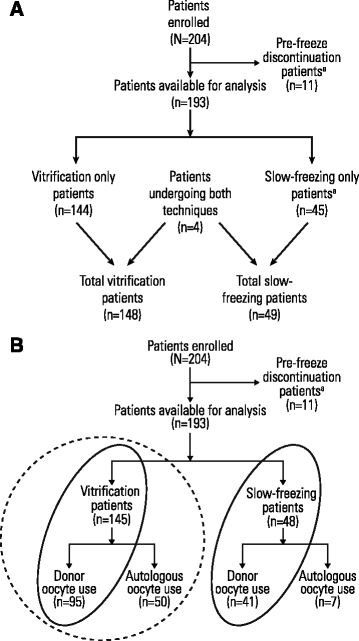The Human Oocyte Preservation Experience (HOPE) Registry: evaluation of cryopreservation techniques and oocyte source on outcomes
- PMID: 28173814
- PMCID: PMC5296964
- DOI: 10.1186/s12958-017-0228-7
The Human Oocyte Preservation Experience (HOPE) Registry: evaluation of cryopreservation techniques and oocyte source on outcomes
Abstract
Background: This prospective, Phase IV, multicenter, observational registry of assisted reproductive technology clinics in the USA studied outcomes of first cycles using thawed/warmed cryopreserved (by slow-freezing/vitrification) oocytes (autologous or donor).
Methods: Patients were followed up through implantation, clinical pregnancy, and birth outcomes. The main outcome measure was live birth rate (LBR), defined as the ratio of live births to oocytes thawed/warmed minus the number of embryos cryopreserved for each cycle, averaged over all thawing cycles. Clinical pregnancy rate (CPR) was also evaluated, and was defined as the presence of a fetal sac with heart activity, as detected by ultrasound scan performed on Day 35-42 after embryo transfer.
Results: A total of 16 centers enrolled 204 patients; data from 193 patients were available for analyses. For donor oocytes, in the slow-freezing (n = 40) versus vitrification (n = 94) groups, respectively, CPR and LBR were significantly different: 32.4% versus 62.6%, and 25.0% versus 52.1%; outcomes from Day 3 transfers did not differ significantly. For vitrified oocytes, in the autologous (n = 46) versus donor (n = 94) group, respectively, CPR and LBR were significantly different: 30.0% versus 62.6% and 17.4% versus 52.1%. This was largely due to a significant difference in CPR with Day 5/6 transfers.
Conclusions: In two subgroup data analyses, in women who received cryopreserved oocytes from donors, CPR and LBR were significantly higher in cycles using oocytes cryopreserved via vitrification versus slow-freezing, reflecting differences in methodologies and more Day 5/6 transfers; in women who received vitrified oocytes, CPR and LBR were significantly higher in cycles using donor versus autologous oocytes with Day 5/6 transfers.
Trial registration: ClinicalTrials.gov: NCT00699400 . Registered June 13, 2008.
Keywords: Assisted reproductive technology; Autologous oocytes; Donor oocytes; Slow-freezing; Vitrification.
Figures

Similar articles
-
Vitrification of cleavage stage day 3 embryos results in higher live birth rates than conventional slow freezing: a RCT.Hum Reprod. 2015 Aug;30(8):1820-30. doi: 10.1093/humrep/dev134. Epub 2015 Jun 18. Hum Reprod. 2015. PMID: 26089301 Clinical Trial.
-
Clinical outcomes of a vitrified donor oocyte programme: A single UK centre experience.Eur J Obstet Gynecol Reprod Biol. 2018 Jun;225:136-140. doi: 10.1016/j.ejogrb.2018.04.017. Epub 2018 Apr 22. Eur J Obstet Gynecol Reprod Biol. 2018. PMID: 29709727
-
Successful elective and medically indicated oocyte vitrification and warming for autologous in vitro fertilization, with predicted birth probabilities for fertility preservation according to number of cryopreserved oocytes and age at retrieval.Fertil Steril. 2016 Feb;105(2):459-66.e2. doi: 10.1016/j.fertnstert.2015.10.026. Epub 2015 Nov 18. Fertil Steril. 2016. PMID: 26604065
-
Evolution of human oocyte cryopreservation: slow freezing versus vitrification.Curr Opin Endocrinol Diabetes Obes. 2016 Dec;23(6):445-450. doi: 10.1097/MED.0000000000000289. Curr Opin Endocrinol Diabetes Obes. 2016. PMID: 27653002 Review.
-
A critical appraisal of cryopreservation (slow cooling versus vitrification) of human oocytes and embryos.Hum Reprod Update. 2012 Sep-Oct;18(5):536-54. doi: 10.1093/humupd/dms016. Epub 2012 Apr 25. Hum Reprod Update. 2012. PMID: 22537859 Review.
Cited by
-
Fertility preservation in pediatric healthcare: a review.Front Endocrinol (Lausanne). 2023 May 3;14:1147898. doi: 10.3389/fendo.2023.1147898. eCollection 2023. Front Endocrinol (Lausanne). 2023. PMID: 37206440 Free PMC article. Review.
-
Oocyte Cryopreservation for Medical and Planned Indications: A Practical Guide and Overview.J Clin Med. 2023 May 18;12(10):3542. doi: 10.3390/jcm12103542. J Clin Med. 2023. PMID: 37240648 Free PMC article. Review.
-
Cryobiology in human ARTs: then and now.J Assist Reprod Genet. 2018 Jul;35(7):1133-1134. doi: 10.1007/s10815-018-1269-3. J Assist Reprod Genet. 2018. PMID: 30030713 Free PMC article. No abstract available.
-
Outcomes of Social Egg Freezing: A Cohort Study and a Comprehensive Literature Review.J Clin Med. 2023 Jun 21;12(13):4182. doi: 10.3390/jcm12134182. J Clin Med. 2023. PMID: 37445218 Free PMC article.
-
Combined use of medically-assisted reproductive techniques: a new bioethical issue.Acta Biomed. 2019 Sep 30;90(10-S):58-61. doi: 10.23750/abm.v90i10-S.8761. Acta Biomed. 2019. PMID: 31577256 Free PMC article. Review.
References
-
- Chang CC, Elliott TA, Wright G, Shapiro DB, Toledo AA, Nagy ZP. Prospective controlled study to evaluate laboratory and clinical outcomes of oocyte vitrification obtained in in vitro fertilization patients aged 30 to 39 years. Fertil Steril. 2013;99:1891–7. doi: 10.1016/j.fertnstert.2013.02.008. - DOI - PubMed
Publication types
MeSH terms
Associated data
LinkOut - more resources
Full Text Sources
Other Literature Sources
Medical

